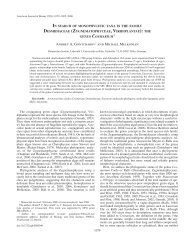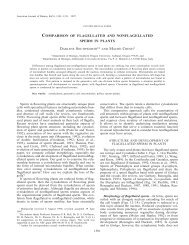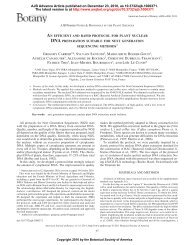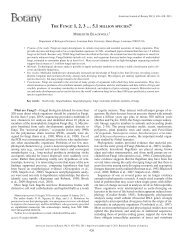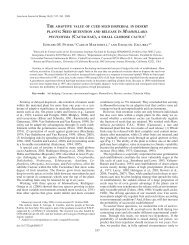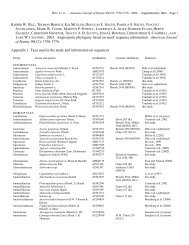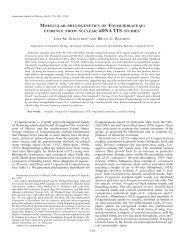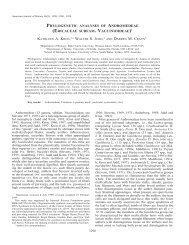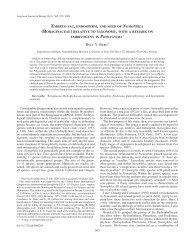genetic variation and structure in the expanding moss pogonatum ...
genetic variation and structure in the expanding moss pogonatum ...
genetic variation and structure in the expanding moss pogonatum ...
You also want an ePaper? Increase the reach of your titles
YUMPU automatically turns print PDFs into web optimized ePapers that Google loves.
American Journal of Botany 92(10): 1684–1690. 2005.<br />
GENETIC VARIATION AND STRUCTURE IN THE<br />
EXPANDING MOSS POGONATUM DENTATUM<br />
(POLYTRICHACEAE) IN ITS AREA OF ORIGIN AND IN A<br />
RECENTLY COLONIZED AREA 1<br />
KRISTIAN HASSEL, 2,4 SIGURD M. SÅSTAD, 2 URBAN GUNNARSSON, 3 AND<br />
LARS SÖDERSTRÖM 3<br />
2<br />
Museum of Natural History <strong>and</strong> Archaeology, Norwegian University of Science <strong>and</strong> Technology, N-7491 Trondheim, Norway; <strong>and</strong><br />
3<br />
Department of Biology, Norwegian University of Science <strong>and</strong> Technology, N-7491 Trondheim, Norway<br />
Genetic <strong>variation</strong> <strong>in</strong> <strong>the</strong> exp<strong>and</strong><strong>in</strong>g <strong>moss</strong> species Pogonatum dentatum was studied us<strong>in</strong>g <strong>in</strong>tersimple sequence repeat (ISSR) markers.<br />
The <strong>genetic</strong> consequences of range expansion were studied by compar<strong>in</strong>g source populations <strong>in</strong> a mounta<strong>in</strong> area with populations from<br />
a recently colonized lowl<strong>and</strong> area <strong>in</strong> Sweden. Indices of <strong>genetic</strong> <strong>variation</strong> show slightly lower number of alleles per locus <strong>in</strong> <strong>the</strong><br />
lowl<strong>and</strong>s <strong>and</strong> a similar gene diversity <strong>in</strong> both areas. Three of four lowl<strong>and</strong> populations had evidence of a recently passed bottleneck.<br />
Considerably higher haplotype diversity was found <strong>in</strong> <strong>the</strong> recently colonized lowl<strong>and</strong>s compared to source populations <strong>in</strong> <strong>the</strong> mounta<strong>in</strong>s.<br />
Patterns of allelic diversity suggest that P. dentatum experiences loss of <strong>genetic</strong> <strong>variation</strong> through founder effects <strong>and</strong> <strong>genetic</strong> drift<br />
when exp<strong>and</strong><strong>in</strong>g its distribution range. Higher haplotypic diversity, less l<strong>in</strong>kage disequilibrium, <strong>and</strong> fewer compatible loci <strong>in</strong>dicate that<br />
sexual recomb<strong>in</strong>ation is relatively more important <strong>in</strong> <strong>the</strong> lowl<strong>and</strong>s compared to <strong>the</strong> mounta<strong>in</strong>s. A likely explanation is higher success<br />
of establishment from spores <strong>in</strong> <strong>the</strong> lowl<strong>and</strong>s, while clonal propagation predom<strong>in</strong>ates <strong>in</strong> <strong>the</strong> mounta<strong>in</strong>s. Less <strong>genetic</strong> differentiation<br />
among lowl<strong>and</strong> populations <strong>in</strong>dicates more gene flow <strong>in</strong> <strong>the</strong> lowl<strong>and</strong> area, <strong>in</strong>volv<strong>in</strong>g more spores <strong>and</strong>/or fragments mov<strong>in</strong>g among<br />
populations.<br />
Key words:<br />
Sweden.<br />
bottleneck; bryophyte; clonal plant; gene flow; <strong>in</strong>ter-simple sequence repeats (ISSR); <strong>in</strong>vasive species; recomb<strong>in</strong>ation;<br />
Genetic diversity of species that are exp<strong>and</strong><strong>in</strong>g <strong>the</strong>ir ranges,<br />
<strong>and</strong> of <strong>in</strong>vasive species <strong>in</strong> particular, has been given <strong>in</strong>creased<br />
attention dur<strong>in</strong>g <strong>the</strong> last decade due to easier access to molecular<br />
methods (e.g., Stiller <strong>and</strong> Denton, 1995; Tsutsui et al.,<br />
2000; Marston <strong>and</strong> Villalard-Bohnsack, 2002). This has <strong>in</strong>creased<br />
<strong>the</strong> knowledge of <strong>genetic</strong> consequences of range expansions.<br />
Population bottlenecks through founder effects are<br />
thought to be important <strong>in</strong> reduc<strong>in</strong>g <strong>genetic</strong> diversity <strong>in</strong> populations<br />
of exp<strong>and</strong><strong>in</strong>g species (Amsellem et al., 2000; Le Page<br />
et al., 2000), but exceptions exist. Holl<strong>and</strong> (2001) found no<br />
evidence of founder effects <strong>in</strong> <strong>in</strong>vasive populations of brown<br />
mussel (Perna perna L.), <strong>and</strong> Berg et al. (2002) found that <strong>the</strong><br />
effects of founder events measured as heterozygosity became<br />
undetectable with<strong>in</strong> 7 years <strong>in</strong> <strong>the</strong> crustacean Bythotrephes<br />
longimanus Leydig. The success of a species exp<strong>and</strong><strong>in</strong>g its<br />
range does not seem to depend on extensive <strong>genetic</strong> <strong>variation</strong><br />
(Marston <strong>and</strong> Villalard-Bohnsack, 2002; Xu et al., 2003), although<br />
<strong>the</strong> level of <strong>genetic</strong> <strong>variation</strong> should have consequences<br />
for evolutionary potential <strong>and</strong> adaptation by natural selection<br />
to new environments.<br />
Life-history characteristics may affect <strong>the</strong> <strong>genetic</strong> diversity<br />
<strong>and</strong> <strong>structure</strong> <strong>in</strong> a species exp<strong>and</strong><strong>in</strong>g its range. Species characteristics<br />
such as generation time, fecundity, reproductive system,<br />
<strong>and</strong> mode of dispersal will <strong>in</strong>fluence levels of <strong>genetic</strong><br />
<strong>variation</strong> <strong>and</strong>, hence, <strong>the</strong> ability to respond evolutionarily to<br />
environmental change. Dispersal potential (i.e., number, size<br />
1<br />
Manuscript received 25 January 2005; revision accepted 25 June 2005.<br />
The authors thank Robert Wyatt for helpful comments on <strong>the</strong> manuscript,<br />
M. D. Hansen for valuable help with <strong>the</strong> <strong>genetic</strong> analysis <strong>and</strong> Terry Hedderson<br />
for <strong>in</strong>troduc<strong>in</strong>g ISSRs to K.H. The work is part of <strong>the</strong> first author’s Ph.D.<br />
<strong>the</strong>sis <strong>and</strong> was f<strong>in</strong>anced by <strong>and</strong> performed at <strong>the</strong> Department of Biology,<br />
Norwegian University of Science <strong>and</strong> Technology.<br />
4<br />
Author for correspondence (e-mail: kristian.hassel@vm.ntnu.no)<br />
1684<br />
<strong>and</strong> transportability of diaspores) <strong>and</strong> frequency of sexual reproduction<br />
is likely to affect <strong>the</strong> degree of <strong>genetic</strong> <strong>variation</strong><br />
<strong>and</strong> <strong>structure</strong>. Populations with restricted dispersal ability, produc<strong>in</strong>g<br />
only large asexual diaspores, should have lower levels<br />
of <strong>genetic</strong> differentiation <strong>and</strong> haplotype diversity compared to<br />
outcross<strong>in</strong>g populations with small dispersible diaspores (Baatout<br />
et al., 1991; Treu et al., 2001). Many <strong>in</strong>vasive plants undergo<br />
evolutionary shifts to more self<strong>in</strong>g (cf. Amsellem et al.,<br />
2001) or asexual reproduction (Pellegr<strong>in</strong> <strong>and</strong> Hauber, 1999),<br />
which may reduce <strong>genetic</strong> <strong>variation</strong> <strong>in</strong> newly founded populations.<br />
Species exp<strong>and</strong><strong>in</strong>g <strong>the</strong>ir range often have good dispersal<br />
ability, <strong>and</strong> a high degree of gene flow is expected (Sakai<br />
et al., 2001). This could lead to ma<strong>in</strong>tenance of <strong>genetic</strong><br />
<strong>variation</strong> <strong>in</strong> <strong>the</strong> exp<strong>and</strong><strong>in</strong>g populations <strong>and</strong> little differentiation<br />
among populations.<br />
Bryophytes are unique among l<strong>and</strong> plants <strong>in</strong> that <strong>the</strong> haploid<br />
gametophyte is <strong>the</strong> longer-lived, <strong>in</strong>dependent, <strong>and</strong> more photosyn<strong>the</strong>tically<br />
active generation. Pogonatum dentatum (Brid.)<br />
Brid. (Bryophyta: Polytrichaceae) is a dioicous <strong>moss</strong> that commonly<br />
reproduces sexually. Orig<strong>in</strong>ally, P. dentatum was ma<strong>in</strong>ly<br />
restricted to arctic <strong>and</strong> alp<strong>in</strong>e areas <strong>in</strong> Fennosc<strong>and</strong>ia (Vaarama,<br />
1967; Hedenäs, 1983). With <strong>the</strong> <strong>in</strong>dustrialization of forestry<br />
<strong>and</strong> extensive build<strong>in</strong>g of forest roads dur<strong>in</strong>g <strong>the</strong> 20th<br />
century, P. dentatum started to colonize lowl<strong>and</strong> localities.<br />
Now it is regularly found on disturbed soil <strong>in</strong> <strong>the</strong> lowl<strong>and</strong>s<br />
east <strong>and</strong> south of its formerly known distribution area (Hassel,<br />
2000).<br />
Comparison of <strong>the</strong> <strong>genetic</strong> composition of recently established<br />
populations with populations <strong>in</strong> <strong>the</strong> orig<strong>in</strong>al range of an<br />
exp<strong>and</strong><strong>in</strong>g species can provide valuable <strong>in</strong>formation about<br />
evolutionary processes <strong>and</strong> temporal <strong>and</strong> spatial patterns of<br />
species range expansions (Sakai et al., 2001). This study <strong>in</strong>vestigates<br />
<strong>genetic</strong> diversity <strong>and</strong> <strong>structure</strong> <strong>in</strong> <strong>the</strong> exp<strong>and</strong><strong>in</strong>g
October 2005] HASSEL ET AL.—GENETIC DIVERSITY OF AN EXPANDING MOSS<br />
1685<br />
<strong>moss</strong> species, P. dentatum, <strong>in</strong> its orig<strong>in</strong>al range <strong>and</strong> <strong>in</strong> a recently<br />
colonized area <strong>in</strong> nor<strong>the</strong>rn Sweden us<strong>in</strong>g ISSR (<strong>in</strong>tersimple<br />
sequence repeats) as molecular markers. Compar<strong>in</strong>g <strong>the</strong><br />
<strong>genetic</strong> composition <strong>in</strong> <strong>the</strong> two areas seeks to describe <strong>the</strong><br />
pattern of molecular <strong>genetic</strong> <strong>variation</strong>, <strong>and</strong> to obta<strong>in</strong> knowledge<br />
about <strong>the</strong> processes shap<strong>in</strong>g <strong>the</strong>se patterns.<br />
Two alternative hypo<strong>the</strong>ses ma<strong>in</strong>ly differ<strong>in</strong>g <strong>in</strong> <strong>the</strong> underly<strong>in</strong>g<br />
dispersal mechanisms can be formulated. Hypo<strong>the</strong>sis 1:<br />
Expansion of P. dentatum is a result of easily dispersed <strong>and</strong><br />
sexually produced spores. Prediction 1.1: Effective spore dispersal<br />
<strong>and</strong> establishment will result <strong>in</strong> high haplotype diversity<br />
<strong>and</strong> spore establishment is found to be common <strong>in</strong> <strong>the</strong> lowl<strong>and</strong>s<br />
while rare <strong>in</strong> <strong>the</strong> mounta<strong>in</strong>s (Hassel <strong>and</strong> Söderström,<br />
2003). Prediction 1.2: Little <strong>genetic</strong> differentiation will take<br />
place among populations, due to effective dispersal. Hypo<strong>the</strong>sis<br />
2: The expansion of P. dentatum is a result of occasional<br />
dispersal of vegetative fragments by, e.g., cars or o<strong>the</strong>r human<br />
activities. Prediction 2.1: Restricted dispersal will keep haplotype<br />
diversity low for a long time after <strong>in</strong>itial establishment.<br />
Prediction 2.2: Genetic differentiation will take place among<br />
populations due to low gene flow (restricted dispersal). In addition,<br />
low levels of <strong>genetic</strong> <strong>variation</strong> are expected with<strong>in</strong> populations<br />
due to local recruitment by locally dispersed asexual<br />
fragments.<br />
If sexual reproduced spores are <strong>the</strong> ma<strong>in</strong> agent of dispersal,<br />
no l<strong>in</strong>kage among loci is expected. In contrast, high l<strong>in</strong>kage<br />
(l<strong>in</strong>kage disequilibrium) is expected if asexual reproduction by<br />
fragments is dom<strong>in</strong>at<strong>in</strong>g. For both scenarios of dispersal, we<br />
predict that newly established populations would experience a<br />
bottleneck with loss of rare alleles.<br />
MATERIALS AND METHODS<br />
Study species—Pogonatum dentatum has acrocarpous growth <strong>and</strong> is frequently<br />
recorded with sporophytes <strong>in</strong> both mounta<strong>in</strong> <strong>and</strong> lowl<strong>and</strong> areas.<br />
Spores are small (17–22 m diameter), produced <strong>in</strong> large quantities (200 000–<br />
450 000 per capsule), <strong>and</strong> are potentially important <strong>in</strong> long-distance dispersal<br />
(Hassel <strong>and</strong> Söderström, 2003). It lacks specialized asexual diaspores, but<br />
fragmentation is potentially important for local dispersal. Asexual reproduction<br />
by fragmentation may take place from a s<strong>in</strong>gle leaf or larger fragments<br />
like part of a stem (Hassel <strong>and</strong> Söderström, 2003). Vegetative reproduction<br />
by rhizoid wicks such as known for Polytrichum species (Wiggelsworth,<br />
1947) has been searched for <strong>in</strong> P. dentatum, but not found (K. Hassel, unpublished).<br />
Establishment from spores <strong>and</strong> fragments is common <strong>in</strong> <strong>the</strong> lowl<strong>and</strong><br />
area, but seems to be less frequent <strong>in</strong> <strong>the</strong> mounta<strong>in</strong> area (Hassel <strong>and</strong><br />
Söderström, 1999, 2003). In <strong>the</strong> study area, P. dentatum typically occurs on<br />
disturbed m<strong>in</strong>eral soil. In <strong>the</strong> mounta<strong>in</strong>s, <strong>the</strong> ma<strong>in</strong> disturbance factors are frost<br />
heav<strong>in</strong>g <strong>and</strong> w<strong>in</strong>d, whereas <strong>in</strong> <strong>the</strong> lowl<strong>and</strong>s road construction <strong>and</strong> ma<strong>in</strong>tenance<br />
are <strong>the</strong> most common causes of soil disturbances that lead to creation of new<br />
habitats.<br />
Study area—Populations were sampled from two areas <strong>in</strong> nor<strong>the</strong>rn Sweden<br />
(Fig. 1) <strong>in</strong> August 2001. The mounta<strong>in</strong> area is <strong>in</strong> <strong>the</strong> alp<strong>in</strong>e region at Stekenjokk<br />
(6505N, 1430E; 800 m a.s.l.) on a mounta<strong>in</strong> heath above <strong>the</strong> tree<br />
limit. The lowl<strong>and</strong> area is <strong>in</strong> <strong>the</strong> boreal region at Junsele (6345N, 1715E,<br />
altitude 300 m a.s.l.) <strong>in</strong> spruce forest. The mounta<strong>in</strong> <strong>and</strong> lowl<strong>and</strong> areas are<br />
part of <strong>the</strong> same valley <strong>and</strong> river system, Ångermanälven. If range expansion<br />
takes place by stepwise dispersal, this would be a natural colonization route,<br />
because expansion of forestry activity followed <strong>the</strong> valley system toward <strong>the</strong><br />
mounta<strong>in</strong>s.<br />
Fig. 1. Map of Sc<strong>and</strong><strong>in</strong>avia <strong>in</strong>dicat<strong>in</strong>g <strong>the</strong> Swedish study sites <strong>in</strong> <strong>the</strong> lowl<strong>and</strong><br />
area (L) <strong>and</strong> mounta<strong>in</strong> area (M). The small maps <strong>in</strong>dicate <strong>the</strong> distance<br />
between <strong>the</strong> studied populations (1–6, 10, 12) with<strong>in</strong> each area.<br />
Sampl<strong>in</strong>g <strong>and</strong> DNA analysis—Four populations of P. dentatum were sampled<br />
from both <strong>the</strong> mounta<strong>in</strong> <strong>and</strong> lowl<strong>and</strong> areas (Table 1). A population was<br />
delimited as a group of patches of P. dentatum shoots occurr<strong>in</strong>g at a restricted<br />
site. In each of <strong>the</strong> eight populations, a transect was placed from <strong>the</strong> population<br />
edge towards its centre. Along each transect, five patches (cluster of<br />
shoots that consist of one or more <strong>in</strong>dividuals/genets) separated by 2–2.5 m<br />
were sampled. From each patch, five shoots (gametophores/ramets) were sampled<br />
from a quadrat (10 10 cm), one shoot from each corner <strong>and</strong> one from<br />
<strong>the</strong> center. Shoots were put <strong>in</strong> paper bags, air dried, <strong>and</strong> stored at 4C until<br />
analyzed.<br />
ISSR markers where chosen because <strong>the</strong>y are easy <strong>and</strong> <strong>in</strong>expensive to apply<br />
<strong>and</strong> have been successfully used <strong>in</strong> population studies of vascular plants (e.g.,<br />
Wolfe et al., 1998; Yannic et al., 2004) <strong>and</strong> bryophytes (e.g., Korpela<strong>in</strong>en <strong>and</strong><br />
Virtanen, 2003; V<strong>and</strong>erpoorten et al., 2003; Gunnarsson et al., 2005). The<br />
shoots were washed <strong>in</strong> sterile water before DNA extraction. DNA extraction,<br />
PCR setup, <strong>and</strong> visualization of PCR products followed Hassel <strong>and</strong> Gunnarsson<br />
(2003). The <strong>in</strong>tersimple sequence repeat (ISSR) primers, anneal<strong>in</strong>g temperature,<br />
<strong>and</strong> <strong>the</strong> number of scoreable fragments per primer are shown <strong>in</strong><br />
Table 2. B<strong>and</strong>s were scored manually, <strong>and</strong> a table of presence/absence of<br />
ISSR fragments was compiled.<br />
Data analysis—Assessment of <strong>genetic</strong> <strong>variation</strong> from sampl<strong>in</strong>g of ramets<br />
<strong>in</strong> clonal organisms is problematic. Estimat<strong>in</strong>g allele frequencies at <strong>the</strong> ramet<br />
level runs <strong>the</strong> risk of pseudoreplication because some haplotypes may be<br />
represented more than once <strong>in</strong> <strong>the</strong> population, whereas <strong>in</strong> genet-level calculations<br />
different genets with identical multilocus haplotypes cannot be dist<strong>in</strong>-
1686 AMERICAN JOURNAL OF BOTANY<br />
[Vol. 92<br />
TABLE 1. Area occupied by a population (Pop. area), <strong>the</strong> size of <strong>the</strong> largest patch <strong>in</strong> a population (Max. patch size), <strong>and</strong> <strong>the</strong> total number of<br />
patches constitut<strong>in</strong>g a population of Pogonatum dentatum <strong>in</strong> <strong>the</strong> mounta<strong>in</strong>s (M) <strong>and</strong> lowl<strong>and</strong>s (L) of nor<strong>the</strong>rn Sweden.<br />
Population Latitude Longitude<br />
Altitude<br />
(m)<br />
Pop. area<br />
Max. patch<br />
size<br />
M1 Stekenjokk 650555 N 142735 E 822 18 12 m 40 40 cm 12<br />
M2 Stekenjokk 650547 N 142724 E 814 36 15 m 150 150 cm 20<br />
M3 Gervenåkko 650328 N 142156 E 868 16 4m 40 40 cm 8<br />
M10 Stekenjokk 650602 N 142733 E 812 10 14 m 50 50 cm 20<br />
L4 Tärnickberget 634552 N 171425 E 371 70 4m 40 40 cm 20<br />
L5 Asptjärnen 634446 N 171229 E 290 47 5 m cont<strong>in</strong>uous 1<br />
L6 Tärnickberget 634550 N 171407 E 353 19 3m 20 20 cm 15<br />
L12 Båsberget 634735 N 170653 E 273 50 3m 30 30 cm 20<br />
No. of<br />
patches<br />
guished (McLellan et al., 1997). Whe<strong>the</strong>r identical haplotypes could have<br />
orig<strong>in</strong>ated <strong>in</strong>dependently from r<strong>and</strong>om assortment of alleles was tested by<br />
calculat<strong>in</strong>g <strong>the</strong> probability of observ<strong>in</strong>g as many or more ramets with a particular<br />
haplotype than actually observed under a null hypo<strong>the</strong>sis of free recomb<strong>in</strong>ation<br />
(Tibayrenc et al., 1990). Whe<strong>the</strong>r <strong>the</strong> addition of more loci would<br />
<strong>in</strong>crease haplotypic resolution was tested by generat<strong>in</strong>g plots of haplotype<br />
diversity aga<strong>in</strong>st <strong>the</strong> number of loci <strong>in</strong> 100 r<strong>and</strong>om samples of one to 21 loci,<br />
<strong>and</strong> determ<strong>in</strong><strong>in</strong>g whe<strong>the</strong>r <strong>the</strong> relationship reached a plateau.<br />
The number of polymorphic sites (S), mean gene diversity over loci (H S ;<br />
Nei, 1987), mean haplotype diversity (h s ; Nei, 1987), occurrence of shared<br />
haplotypes, <strong>and</strong> pairwise <strong>genetic</strong> distance among populations estimated by<br />
F ST values were analyzed us<strong>in</strong>g <strong>the</strong> computer program ARLEQUIN 2.001<br />
(Schneider et al., 2000). Allelic diversity (A) estimated as mean number of<br />
alleles per locus was calculated for populations <strong>and</strong> areas (corrected for sample<br />
size).<br />
Bottlenecks generate heterozygosity excess because allelic diversity is generally<br />
lost faster than gene diversity dur<strong>in</strong>g a bottleneck (Luikart <strong>and</strong> Cornuet,<br />
1998). To reveal if populations had gone through a bottleneck <strong>the</strong> occurrence<br />
of rare alleles was <strong>in</strong>vestigated. Alleles were considered rare at two levels, if<br />
<strong>the</strong>y occurred <strong>in</strong> 5 <strong>and</strong> 15% of <strong>the</strong> samples. Us<strong>in</strong>g <strong>the</strong> computer program<br />
BOTTLENECK version 1.2.02 (Luikart <strong>and</strong> Cornuet, 1999), a sign test for reveal<strong>in</strong>g<br />
populations that recently have passed through a bottleneck from allele<br />
frequency data at polymorphic loci under assumption of <strong>the</strong> stepwise mutation<br />
model (SMM) <strong>and</strong> <strong>the</strong> <strong>in</strong>f<strong>in</strong>ite allele model (IAM) was performed. To be<br />
statistically conservative, one should only use <strong>the</strong> SMM when analyz<strong>in</strong>g microsatellite<br />
data, but because <strong>the</strong> true model of mutation for most loci is<br />
<strong>in</strong>termediate between IAM <strong>and</strong> SMM, us<strong>in</strong>g both models is recommended<br />
(Luikart <strong>and</strong> Cornuet, 1998). ISSRs <strong>and</strong> microsatellites are of similar orig<strong>in</strong><br />
(simple sequence repeats, Godw<strong>in</strong> et al., 1997) <strong>and</strong> should follow <strong>the</strong> same<br />
mutation model.<br />
L<strong>in</strong>kage disequilibrium <strong>and</strong> character compatibility analyses were performed<br />
to assess whe<strong>the</strong>r marker distributions orig<strong>in</strong>ated from sexual or asexual<br />
reproduction <strong>in</strong> <strong>the</strong> different populations. Multilocus l<strong>in</strong>kage disequilibrium<br />
was <strong>in</strong>ferred us<strong>in</strong>g <strong>the</strong> <strong>in</strong>dex of association modified to remove <strong>the</strong> dependency<br />
of sample size ( r d ; Agapow <strong>and</strong> Burt, 2001). Calculation of statistics<br />
<strong>and</strong> tests of significance by r<strong>and</strong>omization were performed with <strong>the</strong> program<br />
Multilocus v1.2 (http://www.bio.ic.uk/evolve/software/multilocus).<br />
Compatibility methods search for <strong>the</strong> largest set of mutually compatible<br />
characters. For a pair of bi-allelic markers, this means that no more than three<br />
of <strong>the</strong> four possible genotypes should be present. Asexual l<strong>in</strong>eages are assumed<br />
to accumulate unique somatic mutations arrang<strong>in</strong>g <strong>the</strong> genets <strong>in</strong> a treelike<br />
<strong>structure</strong>. Therefore, none or a small fraction only (due to parallel mutations)<br />
of <strong>the</strong> loci, are expected to be <strong>in</strong>compatible. The sum of <strong>in</strong>compatible<br />
loci over all pairwise comparisons (matrix <strong>in</strong>compatibility, Wilk<strong>in</strong>son, 2001),<br />
can hence be used as a measure of recomb<strong>in</strong>ation (Mes, 1998; van der Hulst<br />
et al., 2000). Matrix <strong>in</strong>compatibility <strong>and</strong> <strong>the</strong> observed conflict compared to<br />
<strong>the</strong> conflict <strong>in</strong> r<strong>and</strong>omly permuted data (<strong>in</strong>compatibility excess ratio, Wilk<strong>in</strong>son,<br />
2001) <strong>in</strong> all populations were estimated.<br />
To <strong>in</strong>vestigate <strong>the</strong> <strong>genetic</strong> <strong>structure</strong> an analysis of molecular variance<br />
(AMOVA) of <strong>the</strong> ISSR data (analogous to RFLP data), ARLEQUIN 2.001<br />
(Schneider et al., 2000) was used to exam<strong>in</strong>e <strong>genetic</strong> <strong>variation</strong> at area, population,<br />
<strong>and</strong> patch levels for both ramets <strong>and</strong> genets. The level of <strong>genetic</strong><br />
differentiation was measured by F CT , F SC , <strong>and</strong> F ST , that refer to distance among<br />
groups, among subgroups with<strong>in</strong> groups <strong>and</strong> with<strong>in</strong> subgroups, respectively<br />
(see Table 3). The data were analyzed <strong>in</strong> a hierarchical manner to estimate<br />
variance components at <strong>the</strong> different spatial scales.<br />
RESULTS<br />
PCR products correspond<strong>in</strong>g to 39 alleles at 21 loci, amplified<br />
by <strong>the</strong> four primers were scored <strong>in</strong> 194 shoots. Eighteen<br />
loci were polymorphic <strong>and</strong> a total of 64 haplotypes could be<br />
dist<strong>in</strong>guished. The number of ramets of <strong>the</strong> most common haplotype<br />
<strong>in</strong> all populations was significantly higher from what<br />
we would expect if <strong>the</strong> populations reproduced solely sexually<br />
i.e., free recomb<strong>in</strong>ation (P hap , Table 3). This suggests that predom<strong>in</strong>ant<br />
haplotypes are asexually produced <strong>and</strong> that some<br />
genets are sampled more than once. The addition of more loci<br />
<strong>in</strong>creased <strong>the</strong> haplotypic resolution <strong>in</strong> <strong>the</strong> lowl<strong>and</strong>s, while resolution<br />
seemed to be satisfactory <strong>in</strong> <strong>the</strong> mounta<strong>in</strong>s where <strong>the</strong><br />
number of haplotypes reaches a maximum (Fig. 2). Thus, haplotype<br />
diversity <strong>in</strong> <strong>the</strong> lowl<strong>and</strong>s should be considered as a<br />
m<strong>in</strong>imum estimate. Results from analyses at <strong>the</strong> genet level<br />
are presented next. However, results from <strong>the</strong> ramet level are<br />
<strong>in</strong>cluded <strong>in</strong> Table 3 for comparison.<br />
Haplotype diversity was higher <strong>in</strong> <strong>the</strong> lowl<strong>and</strong>s than <strong>in</strong> <strong>the</strong><br />
mounta<strong>in</strong>s (mean of 11.5 <strong>and</strong> 6.0 haplotypes, respectively; N g ,<br />
Table 3). Mean percentage of polymorphic loci (P p ) was highest<br />
<strong>in</strong> <strong>the</strong> lowl<strong>and</strong> populations (39 vs. 32% <strong>in</strong> <strong>the</strong> mounta<strong>in</strong>s).<br />
TABLE 2. Primers used <strong>in</strong> <strong>the</strong> <strong>in</strong>tersimple sequence repeat (ISSR) analysis of Pogonatum dentatum, <strong>the</strong> number of scored <strong>and</strong> polymorphic loci,<br />
<strong>and</strong> <strong>the</strong> primer-specific anneal<strong>in</strong>g temperature.<br />
Primer<br />
name Primer sequence (5-3) No. of loci<br />
No. of<br />
polymorphic loci<br />
UBC-811 GAG AGA GAG AGA GAG AC 7 6 50<br />
UBC-825 ACA CAC ACA CAC ACA CT 2 2 48<br />
UBC-841 GAG AGA GAG AGA GAG AYC 3 2 52<br />
UBC-888 BDB CAC ACA CAC ACA CA 9 8 52<br />
Note: Y C, T; B C, G, T; D A, G, T.<br />
Anneal<strong>in</strong>g<br />
temp. (C)
October 2005] HASSEL ET AL.—GENETIC DIVERSITY OF AN EXPANDING MOSS<br />
1687<br />
TABLE 3. Genetic variability with<strong>in</strong> populations of Pogonatum dentatum <strong>in</strong> <strong>the</strong> mounta<strong>in</strong>s (M) <strong>and</strong> lowl<strong>and</strong>s (L) of nor<strong>the</strong>rn Sweden, detected by<br />
<strong>in</strong>tersimple sequence repeat (ISSR) analysis.<br />
Population N r /N g S P p A r /A g h s SD H Sr SD/H Sg SD r¯d IER P hap<br />
M1 25/6 8 38.1 1.44/1.66 0.833 0.034 0.151 0.090/0.181 0.122 0.040 ns 0.339 ns 8.2 10 6<br />
M2 25/5 4 19.0 1.24/1.49 0.300 0.118 0.038 0.032/0.095 0.075 0.056 ns ND 0.0176<br />
M3 25/5 9 42.9 1.49/1.79 0.690 0.056 0.158 0.093/0.219 0.151 0.016 ns 0.162 ns 6.2 10 13<br />
M10 25/8 6 28.6 1.34/1.47 0.757 0.060 0.120 0.074/0.153 0.100 0.045 ns 0.050 ns 2.8 10 6<br />
L4 25/12 8 38.1 1.44/1.51 0.910 0.032 0.148 0.089/0.154 0.096 0.023 ns 0.001 ns 1.1 10 9<br />
L5 23/12 10 47.6 1.54/1.61 0.909 0.036 0.186 0.108/0.187 0.113 0.033 ns 0.174 ns 1.5 10 7<br />
L6 25/11 9 42.9 1.49/1.57 0.907 0.032 0.157 0.093/0.168 0.104 0.010 ns 0.034 ns 0.0028<br />
L12 21/11 6 28.6 1.35/1.41 0.891 0.045 0.138 0.084/0.145 0.092 0.042 ns 0.058 ns 0.0001<br />
Note: N r /N g number of sampled ramets <strong>and</strong> genets (haplotypes), respectively; S number of polymorphic sites; P p percentage of polymorphic<br />
loci; A r /A g mean number of alleles per locus (corrected for sample size) at <strong>the</strong> ramet <strong>and</strong> genet level, respectively; h s mean haplotype diversity;<br />
H Sr /H Sg mean gene diversity at <strong>the</strong> ramet <strong>and</strong> genet level, respectively; r¯d multilocus l<strong>in</strong>kage disequilibrium; IER <strong>in</strong>compatibility excess<br />
ratio <strong>and</strong> P hap <strong>the</strong> probability of observ<strong>in</strong>g as many ramets of <strong>the</strong> most common haplotype as actually observed <strong>in</strong> a population <strong>in</strong> a sexually<br />
reproduc<strong>in</strong>g population; L <strong>and</strong> M lowl<strong>and</strong> <strong>and</strong> mounta<strong>in</strong> populations, respectively; ND no data; ns non significant.<br />
The mean allelic richness (A g ) was higher <strong>in</strong> <strong>the</strong> mounta<strong>in</strong><br />
populations (1.53 <strong>in</strong> <strong>the</strong> lowl<strong>and</strong>s vs. 1.60 <strong>in</strong> <strong>the</strong> mounta<strong>in</strong>s).<br />
However, <strong>the</strong>re were no clear differences between <strong>the</strong> mounta<strong>in</strong>s<br />
<strong>and</strong> lowl<strong>and</strong>s <strong>in</strong> gene diversity (H Sg ; Table 3). Multilocus<br />
l<strong>in</strong>kage disequilibrium ( r d ) <strong>and</strong> <strong>the</strong> <strong>in</strong>compatibility excess ratio<br />
(IER) did not reveal significant deviations from <strong>the</strong> assumption<br />
of free recomb<strong>in</strong>ation <strong>in</strong> <strong>the</strong> two study areas. However, <strong>the</strong>re<br />
was a trend toward higher l<strong>in</strong>kage <strong>and</strong> more compatible loci<br />
<strong>in</strong> <strong>the</strong> mounta<strong>in</strong>s relative to <strong>the</strong> lowl<strong>and</strong>s (Table 3).<br />
There were three rare alleles <strong>in</strong> both areas us<strong>in</strong>g <strong>the</strong> 5%<br />
criterion. The mean number of rare alleles <strong>in</strong> <strong>the</strong> populations<br />
was 0.75 <strong>and</strong> 0.50 <strong>in</strong> <strong>the</strong> mounta<strong>in</strong>s <strong>and</strong> lowl<strong>and</strong>s, respectively.<br />
Us<strong>in</strong>g <strong>the</strong> 15% criterion, <strong>the</strong>re were more rare alleles <strong>in</strong> <strong>the</strong><br />
mounta<strong>in</strong>s (9, population mean 2.75) than <strong>in</strong> <strong>the</strong> lowl<strong>and</strong>s (4,<br />
population mean 1.25). Analysis of bottlenecks showed that<br />
three of <strong>the</strong> lowl<strong>and</strong> populations (4, 5 <strong>and</strong> 12) had gone<br />
through a bottleneck, while population 6 was <strong>in</strong> mutation-drift<br />
equilibrium (Table 4). In <strong>the</strong> mounta<strong>in</strong> population 1 had gone<br />
through a bottleneck, while populations 2, 3, <strong>and</strong> 10 were <strong>in</strong><br />
mutation-drift equilibrium (Table 4). These analyses where<br />
done on <strong>the</strong> ramet level; reliable analyses could not be done<br />
at <strong>the</strong> genet level due to low sample size.<br />
Hierarchical analysis of <strong>the</strong> <strong>genetic</strong> <strong>structure</strong> showed that<br />
<strong>the</strong> proportion of total <strong>genetic</strong> <strong>variation</strong> that can be ascribed<br />
to differentiation between <strong>the</strong> mounta<strong>in</strong> <strong>and</strong> lowl<strong>and</strong> areas<br />
(F CT ) is close to zero (Table 5a). Genetic structur<strong>in</strong>g appears<br />
to take place among populations with<strong>in</strong> each area (F SC <br />
0.229) <strong>and</strong> with<strong>in</strong> populations (F ST 0.223). About 80% of<br />
<strong>the</strong> total <strong>genetic</strong> <strong>variation</strong> was due to <strong>variation</strong> with<strong>in</strong> populations<br />
<strong>and</strong> ca. 20% was due to <strong>variation</strong> among populations<br />
with<strong>in</strong> <strong>the</strong> two areas. Separate analyses showed clear differences<br />
between <strong>the</strong> mounta<strong>in</strong>s <strong>and</strong> lowl<strong>and</strong> areas with regard<br />
to <strong>the</strong> partition<strong>in</strong>g of <strong>genetic</strong> <strong>variation</strong> among populations. In<br />
<strong>the</strong> mounta<strong>in</strong>s ca. 30% of <strong>the</strong> <strong>genetic</strong> <strong>variation</strong> was among<br />
populations <strong>in</strong> contrast to ca. 15% <strong>in</strong> <strong>the</strong> lowl<strong>and</strong>s (Table 5b).<br />
Genetic distances were greater among populations <strong>in</strong> <strong>the</strong><br />
mounta<strong>in</strong>s than among <strong>the</strong> lowl<strong>and</strong> populations <strong>and</strong> among <strong>the</strong><br />
mounta<strong>in</strong> vs. lowl<strong>and</strong> populations (F ST , Fig. 3).<br />
Two haplotypes occurred both <strong>in</strong> <strong>the</strong> mounta<strong>in</strong> <strong>and</strong> lowl<strong>and</strong><br />
areas, but no haplotypes were shared among <strong>the</strong> mounta<strong>in</strong> populations.<br />
The lowl<strong>and</strong> population L4 shared three haplotypes<br />
with population L5, <strong>and</strong> population L6 shared one haplotype<br />
with L12. In <strong>the</strong> mounta<strong>in</strong> populations edge patches shared<br />
one or more haplotypes with <strong>the</strong> <strong>in</strong>terior patches. In contrast,<br />
no haplotypes were shared between <strong>the</strong> edge patch <strong>and</strong> <strong>in</strong>terior<br />
patches <strong>in</strong> <strong>the</strong> lowl<strong>and</strong> populations. In fact, <strong>the</strong> same haplotypes<br />
occurred <strong>in</strong> more than one patch only with<strong>in</strong> two of <strong>the</strong><br />
TABLE 4. Results from bottleneck analysis of population of Pogonatum<br />
dentatum <strong>in</strong> <strong>the</strong> mounta<strong>in</strong>s (M) <strong>and</strong> lowl<strong>and</strong>s (L) of nor<strong>the</strong>rn<br />
Sweden.<br />
Fig. 2. Investigation of sampl<strong>in</strong>g scale to see if addition of more loci<br />
would <strong>in</strong>crease haplotypic resolution. Plots of haplotype diversity aga<strong>in</strong>st<br />
number of loci, <strong>in</strong> 100 r<strong>and</strong>om samples of 1–21 loci, were generated to see<br />
if <strong>the</strong> relationship reached a plateau. L <strong>and</strong> M refers to lowl<strong>and</strong>s <strong>and</strong> mounta<strong>in</strong>s,<br />
respectively, numbers (1–6, 10, 12) identify populations.<br />
Sign test<br />
Population N H e /H d SMM<br />
IAM<br />
M1 25 7/1 0.033 0.019<br />
M2 25 1/3 0.075 0.393<br />
M3 25 7/2 0.233 0.055<br />
M10 25 4/2 0.337 0.271<br />
L4 25 7/1 0.031 0.023<br />
L5 23 8/2 0.055 0.023<br />
L6 25 6/3 0.227 0.178<br />
L12 21 6/0 0.023 0.006<br />
Note: P values are shown for a sign test under <strong>the</strong> stepwise mutation<br />
model (SMM) <strong>and</strong> <strong>the</strong> <strong>in</strong>f<strong>in</strong>ite allele model (IAM). N no. of ramets<br />
sampled per polymorphic locus, H e /H d <strong>the</strong> heterozygosity excess/<br />
deficiency ratio.
1688 AMERICAN JOURNAL OF BOTANY<br />
[Vol. 92<br />
TABLE 5. (A) Analysis of molecular variance (AMOVA) of Pogonatum dentatum, at <strong>the</strong> genet level, sampled from four populations <strong>in</strong> each area<br />
<strong>and</strong> five patches from each population. L <strong>and</strong> M denote lowl<strong>and</strong> <strong>and</strong> mounta<strong>in</strong> areas, respectively. (B) Separate analysis of <strong>the</strong> mounta<strong>in</strong> <strong>and</strong><br />
lowl<strong>and</strong> areas.<br />
Source of <strong>variation</strong><br />
df<br />
Variance<br />
component<br />
Variance<br />
(%)<br />
Fixation<br />
<strong>in</strong>dex<br />
A) Between areas (L & M) 1 0.020 0.91 F CT 0.009 ns<br />
Among populations with<strong>in</strong> areas 6 0.511 23.17 F SC 0.229***<br />
With<strong>in</strong> populations 62 1.714 77.74 F ST 0.223***<br />
Total 69 2.205<br />
B) Among M populations 3 0.669 30.78 F CT 0.308***<br />
Among M patches with<strong>in</strong> M populations 16 0.136 6.24 F SC 0.090 ns<br />
With<strong>in</strong> M patches 14 1.639 75.46 F ST 0.245*<br />
Total 33 2.172<br />
Among L populations 3 0.385 17.47 F CT 0.175***<br />
Among L patches with<strong>in</strong> L populations 16 0.383 17.38 F SC 0.210***<br />
With<strong>in</strong> L patches 29 1.436 65.15 F ST 0.349***<br />
Total 48 2.204<br />
Note: F CT <strong>variation</strong> among groups divided by total <strong>variation</strong>, F SC <strong>variation</strong> among sub-groups with<strong>in</strong> groups divided by <strong>the</strong> sum of <strong>variation</strong><br />
among sub-groups with<strong>in</strong> groups <strong>and</strong> <strong>variation</strong> with<strong>in</strong> sub-groups, F ST <strong>the</strong> sum of <strong>variation</strong> among groups <strong>and</strong> <strong>variation</strong> among sub-groups with<strong>in</strong><br />
groups divided by total <strong>variation</strong>, ns P 0.05, * P 0.05, *** P 0.001.<br />
four lowl<strong>and</strong> populations (two shared haplotypes between two<br />
patches <strong>in</strong> population L4 <strong>and</strong> one shared haplotype between<br />
two patches <strong>in</strong> population L6).<br />
DISCUSSION<br />
Genetic diversity—The lower allelic diversity (number of<br />
polymorphic loci) <strong>in</strong> <strong>the</strong> lowl<strong>and</strong>s compared to <strong>the</strong> mounta<strong>in</strong>s<br />
could be expla<strong>in</strong>ed by loss of rare alleles dur<strong>in</strong>g colonization<br />
events (Widmer <strong>and</strong> Lexer, 2001). Moreover, founder effects<br />
is supported by <strong>the</strong> bottleneck analyses. No decrease <strong>in</strong> gene<br />
diversity (expected heterozygosity), but reduced allelic diversity<br />
<strong>in</strong> <strong>the</strong> recently colonized lowl<strong>and</strong> area matches <strong>the</strong> pattern<br />
found by Comps et al. (2001). They studied postglacial colonization<br />
of <strong>the</strong> tree Fagus sylvatica L. <strong>and</strong> found decreased<br />
allelic richness <strong>and</strong> even <strong>in</strong>creased gene diversity towards <strong>the</strong><br />
north (more recently colonized areas). Studies of postglacial<br />
colonization of bryophytes have, however, found both reduced<br />
allelic richness <strong>and</strong> gene diversity towards <strong>the</strong> nor<strong>the</strong>rn parts<br />
of <strong>the</strong> distribution (Cronberg, 2000; Th<strong>in</strong>gsgaard, 2001). A<br />
possible explanation for <strong>the</strong> different patterns of gene diversity<br />
is differences <strong>in</strong> dispersal potential. Species with effectively<br />
dispersed diaspores or gametes might be expected to show<br />
Fig. 3. Genetic distance ( 1 SD) among populations between areas,<br />
with<strong>in</strong> <strong>the</strong> mounta<strong>in</strong> area, <strong>and</strong> with<strong>in</strong> <strong>the</strong> lowl<strong>and</strong> area, based on pairwise F ST<br />
values among populations. Mean geographical distance among populations:<br />
mounta<strong>in</strong> to lowl<strong>and</strong>, 197.8 km; with<strong>in</strong> mounta<strong>in</strong>, 3.3 km; <strong>and</strong> with<strong>in</strong> lowl<strong>and</strong>,<br />
4.3 km.<br />
high gene diversity throughout <strong>the</strong>ir range, due to admixture<br />
<strong>and</strong> frequent sexual reproduction. Allelic richness will be (periodically)<br />
reduced by colonization events. In contrast, species<br />
restricted to short-distance dispersal (step-by-step) would experience<br />
series of population bottlenecks <strong>and</strong> <strong>genetic</strong> drift result<strong>in</strong>g<br />
<strong>in</strong> both decreased allelic richness <strong>and</strong> gene diversity,<br />
unless <strong>the</strong>y experience secondary contact (admixture) with<br />
populations from o<strong>the</strong>r areas.<br />
The lower haplotype diversity <strong>and</strong> higher percentage of<br />
shared haplotypes among mounta<strong>in</strong> patches suggests that asexual<br />
reproduction is more prevalent with<strong>in</strong> <strong>the</strong> mounta<strong>in</strong> populations.<br />
All edge patches <strong>in</strong> <strong>the</strong> mounta<strong>in</strong>s share one or more<br />
haplotypes with <strong>the</strong> <strong>in</strong>terior patches, <strong>and</strong> recruitment by fragmentation<br />
is a likely explanation. Production of spores is high<br />
<strong>in</strong> both areas, but Hassel <strong>and</strong> Söderström (1999, 2003) showed<br />
<strong>in</strong> spore germ<strong>in</strong>ation experiments that successful establishment<br />
of sexually produced spores is most common <strong>in</strong> <strong>the</strong> lowl<strong>and</strong>s.<br />
Higher l<strong>in</strong>kage disequilibrium <strong>and</strong> more compatible loci <strong>in</strong> <strong>the</strong><br />
mounta<strong>in</strong> populations fur<strong>the</strong>r suggests relatively more frequent<br />
recomb<strong>in</strong>ation events <strong>in</strong> <strong>the</strong> lowl<strong>and</strong>s compared to <strong>the</strong> mounta<strong>in</strong>s.<br />
In addition to be<strong>in</strong>g more favorable for spore germ<strong>in</strong>ation<br />
per se, <strong>the</strong> lowl<strong>and</strong>s probably have more available substrate<br />
with a more cont<strong>in</strong>uous distribution (roads), <strong>in</strong>creas<strong>in</strong>g<br />
<strong>the</strong> chance of f<strong>in</strong>d<strong>in</strong>g a suitable site for establishment. Although<br />
three of four populations <strong>in</strong> <strong>the</strong> lowl<strong>and</strong>s <strong>and</strong> one population<br />
<strong>in</strong> <strong>the</strong> mounta<strong>in</strong>s showed evidence of recent bottlenecks,<br />
frequent recomb<strong>in</strong>ation comb<strong>in</strong>ed with gene flow may<br />
be an efficient way of remov<strong>in</strong>g effects of founder events<br />
(Berg et al., 2002). Because production of sporophytes is common<br />
<strong>in</strong> both areas, <strong>the</strong> limit<strong>in</strong>g factor seems to be spore establishment<br />
<strong>and</strong> not gamete dispersal or gametangium <strong>and</strong> sporophyte<br />
production. The process of remov<strong>in</strong>g founder effects<br />
may thus take less time <strong>in</strong> <strong>the</strong> lowl<strong>and</strong>s.<br />
Genetic <strong>structure</strong>—No <strong>genetic</strong> differentiation was found<br />
between <strong>the</strong> lowl<strong>and</strong> <strong>and</strong> mounta<strong>in</strong> areas. This is consistent<br />
with some o<strong>the</strong>r studies of bryophytes that have found very<br />
little differentiation between even widely separated areas (e.g.,<br />
Såstad et al., 2000; Th<strong>in</strong>gsgaard, 2001; van der Velde et al.,<br />
2001; Gunnarsson et al., 2005). Stenøien <strong>and</strong> Såstad (1999)<br />
argued that lack of differentiation among populations, even<br />
between <strong>in</strong>tercont<strong>in</strong>ental disjuncts, may be due to large effec-
October 2005] HASSEL ET AL.—GENETIC DIVERSITY OF AN EXPANDING MOSS<br />
1689<br />
tive population sizes <strong>and</strong> little <strong>genetic</strong> drift, <strong>and</strong> hence retention<br />
of ancestral polymorphisms ra<strong>the</strong>r than recurrent gene<br />
flow. Derda <strong>and</strong> Wyatt (1999a, b, 2003), however, found a<br />
high degree of differentiation between regions <strong>in</strong> four Polytrichum<br />
species, so <strong>the</strong>re seems to be no general pattern. Based<br />
on <strong>the</strong> historic expansion of P. dentatum, it is reasonable to<br />
assume that a high proportion of <strong>the</strong> diaspore flow is from<br />
mounta<strong>in</strong>s to <strong>the</strong> lowl<strong>and</strong>s or with<strong>in</strong> <strong>the</strong> lowl<strong>and</strong>s <strong>in</strong> this species.<br />
This would potentially <strong>in</strong>volve many found<strong>in</strong>g events <strong>in</strong><br />
<strong>the</strong> lowl<strong>and</strong>s, <strong>and</strong> we could thus expect some degree of differentiation<br />
between <strong>the</strong> mounta<strong>in</strong> <strong>and</strong> lowl<strong>and</strong> areas because<br />
of <strong>genetic</strong> drift (cf. Barrett <strong>and</strong> Husb<strong>and</strong>, 1999). The reason<br />
that <strong>genetic</strong> differentiation is not observed may be due to both<br />
high rates of gene flow <strong>and</strong> <strong>the</strong> short time s<strong>in</strong>ce range expansion.<br />
Genetic structur<strong>in</strong>g among populations is most prom<strong>in</strong>ent <strong>in</strong><br />
<strong>the</strong> mounta<strong>in</strong> populations. This fits our <strong>in</strong>terpretation, with<br />
more gene flow <strong>in</strong> <strong>the</strong> lowl<strong>and</strong>s due to more frequent establishment<br />
from spores. When a ‘‘w<strong>in</strong>dow’’ for diaspore establishment<br />
opens, diaspores of different orig<strong>in</strong> must arrive.<br />
Whereas this ‘‘w<strong>in</strong>dow’’ is small <strong>in</strong> <strong>the</strong> mounta<strong>in</strong>s it is probably<br />
larger <strong>in</strong> <strong>the</strong> lowl<strong>and</strong>s <strong>in</strong> <strong>the</strong> form of forest roads. Recruitment<br />
<strong>in</strong> <strong>the</strong> mounta<strong>in</strong>s may <strong>in</strong>stead take place ma<strong>in</strong>ly via<br />
asexually produced diaspores (e.g., Longton <strong>and</strong> Schuster,<br />
1983; Kimmerer, 1994), which would lead to low haplotype<br />
<strong>variation</strong> with<strong>in</strong> populations as seem to be <strong>the</strong> case <strong>in</strong> <strong>the</strong><br />
mounta<strong>in</strong>s. Our results from <strong>the</strong> lowl<strong>and</strong>s seems to agree with<br />
van der Velde et al. (2001) who found that sexual reproduction<br />
is <strong>the</strong> most important determ<strong>in</strong>ant of <strong>genetic</strong> <strong>structure</strong> <strong>in</strong> Polytrichum<br />
formosum Hedw. However, effective dispersal <strong>and</strong><br />
successful establishment from spores seems to vary between<br />
species <strong>in</strong> <strong>the</strong> Polytrichaceae as <strong>in</strong>dicated by <strong>the</strong> low <strong>variation</strong><br />
with<strong>in</strong> populations <strong>in</strong> P. commune Hedw., P. juniper<strong>in</strong>um<br />
Hedw., <strong>and</strong> P. piliferum Hedw. (Derda <strong>and</strong> Wyatt, 1999a, b,<br />
2003).<br />
The recent range expansion of P. dentatum <strong>the</strong>refore seems<br />
to have been facilitated by effective spore dispersal <strong>and</strong> extensive<br />
areas with suitable substrate <strong>in</strong> <strong>the</strong> lowl<strong>and</strong>s. Both historical<br />
factors such as <strong>the</strong> extensive build<strong>in</strong>g of forest roads<br />
<strong>and</strong> <strong>the</strong> predom<strong>in</strong>ant establishment from spores <strong>in</strong> <strong>the</strong> lowl<strong>and</strong>s<br />
vs. clonal propagation <strong>in</strong> <strong>the</strong> mounta<strong>in</strong>s, seem to be responsible<br />
for <strong>the</strong> observed differences <strong>in</strong> <strong>genetic</strong> <strong>variation</strong> <strong>and</strong><br />
<strong>structure</strong> between <strong>the</strong> mounta<strong>in</strong> <strong>and</strong> lowl<strong>and</strong> areas.<br />
LITERATURE CITED<br />
AGAPOW, P.M.,AND A. BURT. 2001. Indices of multilocus l<strong>in</strong>kage disequilibrium.<br />
Molecular Ecology Notes 1: 101–102.<br />
AMSELLEM, L., J. L. NOYER, AND M. HOSSAERT-MCKEY. 2001. Evidence<br />
for a switch <strong>in</strong> <strong>the</strong> reproductive biology of Rubus alceifolius (Rosaceae)<br />
towards apomixis, between its native range <strong>and</strong> its area of <strong>in</strong>troduction.<br />
American Journal of Botany 88: 2243–2251.<br />
AMSELLEM, L., J. L. NOYER, T.LE BOURGEOIS, AND M. HOSSAERT-MCKEY.<br />
2000. Comparison of <strong>genetic</strong> diversity of <strong>the</strong> <strong>in</strong>vasive weed Rubus alceifolius<br />
Poir. (Rosaceae) <strong>in</strong> its native range <strong>and</strong> <strong>in</strong> areas of <strong>in</strong>troduction,<br />
us<strong>in</strong>g amplified fragment length polymorphism (AFLP) markers. Molecular<br />
Ecology 9: 443–455.<br />
BAATOUT, H., D. COMBES, AND M. MARRAKCHI. 1991. Reproductive system<br />
<strong>and</strong> population <strong>structure</strong> <strong>in</strong> two Hedysarum subspecies. I. Genetic <strong>variation</strong><br />
with<strong>in</strong> <strong>and</strong> between populations. Genome 34: 396–406.<br />
BERG, D. J., D. W. GARTON, H.J.MACISAAC, V.E.PANOV, AND I. V. TELESH.<br />
2002. Changes <strong>in</strong> <strong>genetic</strong> <strong>structure</strong> of North American Bythotrephes populations<br />
follow<strong>in</strong>g <strong>in</strong>vasion from Lake Ladoga, Russia. Freshwater Biology<br />
47: 275–282.<br />
COMPS, B., D. GOMORY, J.LETOUZEY, B.THIEBAUT, AND R. J. PETIT. 2001.<br />
Diverg<strong>in</strong>g trends between heterozygosity <strong>and</strong> allelic richness dur<strong>in</strong>g postglacial<br />
colonization <strong>in</strong> <strong>the</strong> European beech. Genetics 157: 389–397.<br />
CRONBERG, N. 2000. Genetic diversity of <strong>the</strong> epiphytic bryophyte Leucodon<br />
sciuroides <strong>in</strong> formerly glaciated versus nonglaciated parts of Europe.<br />
Heredity 84: 710–720.<br />
DERDA, G.S.,AND R. WYATT. 1999a. Genetic <strong>variation</strong> <strong>and</strong> population <strong>structure</strong><br />
<strong>in</strong> Polytrichum piliferum (Polytrichaceae). Journal of <strong>the</strong> Hattori<br />
Botanical Laboratory 86: 121–135.<br />
DERDA, G.S., AND R. WYATT. 1999b. Levels of <strong>genetic</strong> <strong>variation</strong> <strong>and</strong> its<br />
partition<strong>in</strong>g <strong>in</strong> <strong>the</strong> wide-rang<strong>in</strong>g <strong>moss</strong> Polytrichum commune. Systematic<br />
Botany 24: 512–528.<br />
DERDA, G.S.,AND R. WYATT. 2003. Genetic <strong>variation</strong> <strong>and</strong> population <strong>structure</strong><br />
<strong>in</strong> Polytrichum juniper<strong>in</strong>um <strong>and</strong> P. strictum (Polytrichaceae). L<strong>in</strong>dbergia<br />
28: 23–40.<br />
GODWIN, I. D., E. A. B. AITKEN, AND L. W. SMITH. 1997. Application of<br />
<strong>in</strong>ter simple sequence repeat (ISSR) markers to plant <strong>genetic</strong>s. Electrophoresis<br />
18: 1524–1528.<br />
GUNNARSSON, U., K. HASSEL, AND L. SÖDERSTRÖM. 2005. Genetic <strong>variation</strong><br />
<strong>in</strong> Swedish populations of Sphagnum angermanicum: effects of <strong>the</strong> life<br />
history <strong>and</strong> potential impact of post glacial dispersal history. The Bryologist<br />
108: 194–203.<br />
HASSEL, K. 2000. Bryophyte profile 2. Pogonatum dentatum (Brid.) Brid.<br />
(Bryopsida: Polytrichaceae). Journal of Bryology 22: 55–60.<br />
HASSEL, K., AND U. GUNNARSSON. 2003. The use of <strong>in</strong>ter simple sequence<br />
repeats (ISSR) <strong>in</strong> bryophyte population studies. L<strong>in</strong>dbergia 28: 152–157.<br />
HASSEL, K., AND L. SÖDERSTRÖM. 1999. Spore germ<strong>in</strong>ation <strong>in</strong> <strong>the</strong> laboratory<br />
<strong>and</strong> spore establishment <strong>in</strong> <strong>the</strong> field <strong>in</strong> Pogonatum dentatum (Brid.) Brid.<br />
L<strong>in</strong>dbergia 24: 3–10.<br />
HASSEL, K., AND L. SÖDERSTRÖM. 2003. Life history <strong>variation</strong> of Pogonatum<br />
dentatum (Brid.) Brid. <strong>in</strong> contrast<strong>in</strong>g habitats. Journal of <strong>the</strong> Hattori Botanical<br />
Laboratory 93: 215–222.<br />
HEDENÄS, L. 1983. Pogonatum dentatum—en norrl<strong>and</strong>s<strong>moss</strong>a på väg söderut.<br />
Svensk Botanisk Tidskrift 77: 147–150.<br />
HOLLAND, B. S. 2001. Invasion without a bottleneck: microsatellite <strong>variation</strong><br />
<strong>in</strong> natural <strong>and</strong> <strong>in</strong>vasive populations of <strong>the</strong> brown mussel Perna perna<br />
(L). Mar<strong>in</strong>e Biotechnology 3: 407–415.<br />
KIMMERER, R. W. 1994. Ecological consequences of sexual versus asexual<br />
reproduction <strong>in</strong> Dicranum flagellare <strong>and</strong> Tetraphis pellucida. Bryologist<br />
97: 20–25.<br />
KORPELAINEN, H., AND V. VIRTANEN. 2003. DNA f<strong>in</strong>gerpr<strong>in</strong>t<strong>in</strong>g of <strong>moss</strong>es.<br />
Journal of Forensic Sciences 48: 804–807.<br />
LE PAGE, S. L., R. A. LIVERMORE, D.W.COOPER, AND A. C. TAYLOR. 2000.<br />
Genetic analysis of a documented population bottleneck: <strong>in</strong>troduced Bennett’s<br />
wallabies (Macropus rufogriseus rufogriseus) <strong>in</strong> New Zeal<strong>and</strong>. Molecular<br />
Ecology 9: 753–763.<br />
LONGTON, R.E.,AND R. M. SCHUSTER. 1983. Reproductive biology. In R.<br />
M. Schuster [ed.], New manual of bryology, 386–462. Hattori Botanical<br />
Laboratory, Nich<strong>in</strong>an, Japan.<br />
LUIKART, G., AND J. M. CORNUET. 1998. Empirical evaluation of a test for<br />
identify<strong>in</strong>g recently bottlenecked populations from allele frequency data.<br />
Conservation Biology 12: 228–237.<br />
LUIKART, G., AND J. M. CORNUET. 1999. BOTTLENECK: a program for<br />
detect<strong>in</strong>g recent effective population size reductions from allele data frequencies.<br />
Available at website, http://www.montpellier.<strong>in</strong>ra.fr/URLB/<br />
bottleneck/bottleneck.html.<br />
MARSTON, M., AND M. VILLALARD-BOHNSACK. 2002. Genetic variability <strong>and</strong><br />
potential sources of Grateloupia doryphora (Halymeniaceae, Rhodophyta),<br />
an <strong>in</strong>vasive species <strong>in</strong> Rhode Isl<strong>and</strong> waters (USA). Journal of Phycology<br />
38: 649–658.<br />
MCLELLAN, A. J., D. PRATI, O.KALTZ, AND B. SCHMID. 1997. Structure <strong>and</strong><br />
analysis of phenotypic <strong>and</strong> <strong>genetic</strong> <strong>variation</strong> <strong>in</strong> clonal plants. In H. de<br />
Kroon <strong>and</strong> J. M. Van Groenendael [eds.], The ecology <strong>and</strong> evolution of<br />
clonal plants, 185–210. Backhuys Publishers, Leiden, Ne<strong>the</strong>rl<strong>and</strong>s.<br />
MES, T. H. M. 1998. Character compatibility of molecular markers to dist<strong>in</strong>guish<br />
asexual <strong>and</strong> sexual reproduction. Molecular Ecology 7: 1719–<br />
1727.<br />
NEI, M. 1987. Molecular evolutionary <strong>genetic</strong>s. Columbia University Press,<br />
New York, New York.<br />
PELLEGRIN, D., AND D. P. HAUBER. 1999. Isozyme <strong>variation</strong> among populations<br />
of <strong>the</strong> clonal species, Phragmites australis (Cav.) Tr<strong>in</strong>. ex Steudel.<br />
Aquatic Botany 63: 241–259.<br />
SAKAI, A. K., F. W. ALLENDORF, J.S.HOLT, D.M.LODGE, J.MOLOFSKY,<br />
K. A. WITH, S.BAUGHMAN,R.J.CABIN,J.E.COHEN,N.C.ELLSTRAND,
1690 AMERICAN JOURNAL OF BOTANY<br />
[Vol. 92<br />
D. E. MCCAULEY, P.O’NEIL, I.M.PARKER, J.N.THOMPSON, AND S.<br />
G. WELLER. 2001. The population biology of <strong>in</strong>vasive species. Annual<br />
Review of Ecology <strong>and</strong> Systematics 32: 305–332.<br />
SÅSTAD, S. M., K. I. FLATBERG, AND L. HANSSEN. 2000. Orig<strong>in</strong>, taxonomy<br />
<strong>and</strong> population <strong>structure</strong> of <strong>the</strong> allopolyploid peat <strong>moss</strong> Sphagnum majus.<br />
Plant Systematics <strong>and</strong> Evolution 225: 73–84.<br />
SCHNEIDER, S., D. ROESSLI, AND L. EXCOFFIER. 2000. Arlequ<strong>in</strong>: a software<br />
for population <strong>genetic</strong>s data analysis, version 2.000. Computer program<br />
<strong>and</strong> documentation distributed through <strong>the</strong> Department of Anthropology<br />
<strong>and</strong> Ecology, University of Geneva, Geneva, Switzerl<strong>and</strong>; available at<br />
website, http://lgb.unige.ch/arlequ<strong>in</strong>/.<br />
STENøIEN, H.K.,AND S. M. SÅSTAD. 1999. Genetic <strong>structure</strong> <strong>in</strong> three haploid<br />
peat <strong>moss</strong>es (Sphagnum). Heredity 82: 391–400.<br />
STILLER, J.W., AND A. L. DENTON. 1995. One hundred years of Spart<strong>in</strong>a<br />
alterniflora (Poaceae) <strong>in</strong> Willapa Bay, Wash<strong>in</strong>gton: r<strong>and</strong>om amplified<br />
polymorphic DNA analysis of an <strong>in</strong>vasive population. Molecular Ecology<br />
4: 355–363.<br />
THINGSGAARD, K. 2001. Population <strong>structure</strong> <strong>and</strong> <strong>genetic</strong> diversity of <strong>the</strong><br />
amphiatlantic haploid peat<strong>moss</strong> Sphagnum aff<strong>in</strong>e (Sphagnopsida). Heredity<br />
87: 485–496.<br />
TIBAYRENC, M., F. KJELLBERG, AND F. J. AYALA. 1990. A clonal <strong>the</strong>ory of<br />
parasitic protozoa: <strong>the</strong> population <strong>structure</strong>s of Entamoeba, Giardia,<br />
Leishmania, Naegleria, Plasmodium, Trichomonas, <strong>and</strong> Trypanosoma<br />
<strong>and</strong> <strong>the</strong>ir medical <strong>and</strong> taxonomical consequences. Proceed<strong>in</strong>gs of <strong>the</strong><br />
National Academy of Sciences, USA 87: 2414–2418.<br />
TREU, R., D. S. HOLMES, B.M.SMITH, D.ASTLEY, M.A.T.JOHNSON, AND<br />
L. J. TRUEMAN. 2001. Allium ampeloprasum var. bab<strong>in</strong>gtonii (Alliaceae):<br />
an isoclonal plant found across a range of habitats <strong>in</strong> SW Engl<strong>and</strong>.<br />
Plant Ecology 155: 229–235.<br />
TSUTSUI, N. D., A. V. SUAREZ, D.A.HOLWAY, AND T. J. CASE. 2000. Reduced<br />
<strong>genetic</strong> <strong>variation</strong> <strong>and</strong> <strong>the</strong> success of an <strong>in</strong>vasive species. Proceed<strong>in</strong>gs<br />
of <strong>the</strong> National Academy of Sciences, USA 97: 5948–5953.<br />
VAN DER HULST, R. G. M., T. H. M. MES, J.C.M.DEN NIJS, AND K. BACH-<br />
MANN. 2000. Amplified fragment length polymorphism (AFLP) markers<br />
reveal that population <strong>structure</strong> of triploid d<strong>and</strong>elions (Taraxacum offic<strong>in</strong>ale)<br />
exhibits both clonality <strong>and</strong> recomb<strong>in</strong>ation. Molecular Ecology 9:<br />
1–8.<br />
VAN DER VELDE, M., L. VAN DE ZANDE, AND R. BIJLSMA. 2001. Genetic<br />
<strong>structure</strong> of Polytrichum formosum <strong>in</strong> relation to <strong>the</strong> breed<strong>in</strong>g system as<br />
revealed by microsatellites. Journal of Evolutionary Biology 14: 288–<br />
295.<br />
VANDERPOORTEN, A., L. HEDENÄS, AND A. L. JACQUEMART. 2003. Differentiation<br />
<strong>in</strong> DNA f<strong>in</strong>gerpr<strong>in</strong>t<strong>in</strong>g <strong>and</strong> morphology among species of <strong>the</strong><br />
pleurocarpous <strong>moss</strong> genus, Rhytidiadelphus (Hylocomiaceae). Taxon 52:<br />
229–236.<br />
VAARAMA, A. 1967. A f<strong>in</strong>d of Pogonatum capillare (Michx.) Brid. <strong>in</strong> sou<strong>the</strong>rn<br />
F<strong>in</strong>l<strong>and</strong> <strong>and</strong> reflections on its bryo-geographical significance. Aquilo<br />
Serie Botanica 6: 209–218.<br />
WIDMER, A., AND C. LEXER. 2001. Glacial refugia: sanctuaries for allelic<br />
richness, but not for gene diversity. Trends <strong>in</strong> Ecology & Evolution 16:<br />
267–269.<br />
WIGGELSWORTH, G. 1947. Reproduction <strong>in</strong> Polytrichum commune L. <strong>and</strong> <strong>the</strong><br />
significance of <strong>the</strong> rhizoid system. Transactions of <strong>the</strong> British Bryological<br />
Society 1: 4–13.<br />
WILKINSON, M. 2001. PICA 4.0: software <strong>and</strong> documentation distributed by<br />
<strong>the</strong> Department of Zoology, Natural History Museum, London, UK;<br />
available at website, http://www.nhm.ac.uk/research-curation/projects/<br />
software/mwphylogeny.html.<br />
WOLFE, A. D., Q. Y. XIANG, AND S. R. KEPHART. 1998. Assess<strong>in</strong>g hybridization<br />
<strong>in</strong> natural populations of Penstemon (Scrophulariaceae) us<strong>in</strong>g hypervariable<br />
<strong>in</strong>tersimple sequence repeat (ISSR) b<strong>and</strong>s. Molecular Ecology<br />
7: 1107–1125.<br />
XU, C. Y., W. J. ZHANG, C.Z.FU, AND B. R. LU. 2003. Genetic diversity of<br />
alligator weed <strong>in</strong> Ch<strong>in</strong>a by RAPD analysis. Biodiversity <strong>and</strong> Conservation<br />
12: 637–645.<br />
YANNIC, G., A. BAUMEL, AND M. AINOUCHE. 2004. Uniformity of <strong>the</strong> nuclear<br />
<strong>and</strong> chloroplast genomes of Spart<strong>in</strong>a maritima (Poaceae), a salt-marsh<br />
species <strong>in</strong> decl<strong>in</strong>e along <strong>the</strong> western European coast. Heredity 93: 182–<br />
188.



